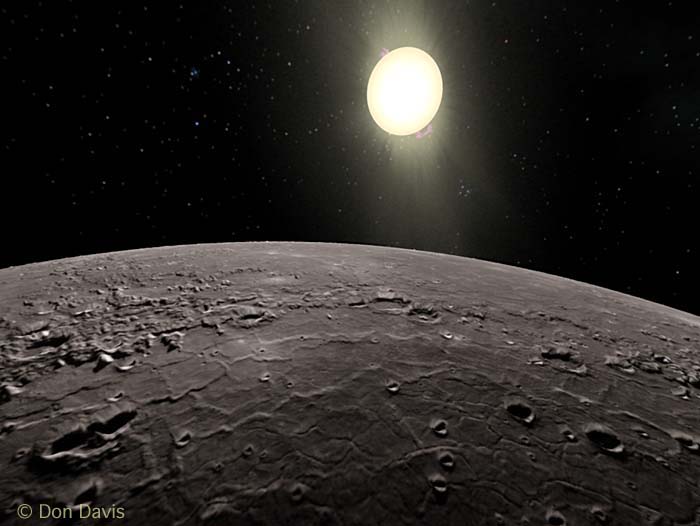
A 'traditional' Planetarium show attempts to create an artificial environment, basically that of the night sky. The capabilities of these theaters are supplemented by landscape projectors and various custom built projectors to suggest specific phenomena such as meteors, the setting sun and such. Except for the sophistication of the projection equipment the Planetarium has largely been an elaboration of the time honored 'Magic Lantern' shows. These early multimedia shows awed audiences practically since the invention of the optical projector in the late 1600's by Christian Huygens until the start of the era of film a century ago.
For many years the only method of filling a dome with a moving image was with wide angle motion picture projection. In the mid 1960's O. Richard Norton, at Flandrau Planetarium in Tucson, began experimenting with 35 mm film shot with a 'fisheye' lens in many picturesque environments. These included time lapse sequences, views of cities and bridges, and a Grand Canyon raft trip. These efforts were encouraging developments at a time when high end Planetarium facilities began to wonder what their future might be in a world of increased audience expectations.
In the early 1970's a variant of the 70 mm IMAX film format was introduced which was designed to be projected in a dome. Using hemispherical view lenses to both film and project with filled the visual field with moving images in a way the wide screen formats introduced in the 1950's could only dream of. Unfortunately, very few films specifically done for domed projection were made, both examples I know of appeared at the debut of the medium! One, 'Garden Isle', was a Hawaii travelogue filmed entirely with a fish eye lens. When projected in the 'Omnimax' theater (as the dome film format was known then), it's high quality fish eye projection lens would nicely reproduce the viewing geometry of the original view when sitting near the center of the dome. I recall feeling like one could toss a pebble and have it go on forever during some aerial shots. The other film mastered in 'Omnimax' was a Solar System travelogue complete with an elaborate model spaceship, and camera moves on landscape models and painted globes. After these promising initial efforts this excellent all dome film format virtually became extinct as a distinct medium in tilted dome theaters. Some IMAX films continued to include token wide angle sequences to give audiences who viewed these films in a dome something to look at, but the use of that medium to capture an immersive environment to it's full capabilities simply died away.
Part of the reason for the virtual extinction of exclusively hemispheric films was the sheer expense and difficulties involved in shooting and handling massive amounts of 70 mm film stock. When shooting time lapse material, for instance, it may be that you have to shoot ten times as much film as you are actually going to be able to use. This is apparently considered cost prohibitive, and a medium rose and in effect collapsed of it's own weight. Later efforts to bring wide angle film into the dome at first tried to get the utmost from careful use of 35mm film, then moved into 70 mm formats. A modest presence has thus been maintained of moving images on the dome, however marginally practical the medium of all dome film projection has proven to be.
When Evans and Sutherland introduced the Digistar projector in the mid 1980's the technology of computer generated video for dome projection was still something of a work in progress, yet the breakthrough represented by using immersive computer graphics as a learning tool was immediately clear to many. Soon a small community of programmers and artists created models and animations which were often shared within a Digiatar user group. As this and other computer graphic all dome systems have advanced in projection quality and usefulness other developments have taken place in the video field which are bringing color moving images into the dome again. During the 1990's several companies began using video in innovative ways to extend it's visual impact. Panoramas using three projectors were one initial accomplishment, using well tuned and blended projectors capable of passing even fine text across the images in perfect registration. This was in effect what the designers of the three film projector 'Cinerama' process had dreamed of doing, but were frustrated by the limitations of film technology. A projected video is rock steady compared to film projectors, and the video signals can be readily synchronized. Variations of multiple video projection appeared, and in the late 1990's clusters of projectors were finally used to fill a dome.
At the beginning of the 21st Century it is ironic that all dome moving images 'in the wild' can still only be acquired with ungainly large format film cameras. Until some digital device exists capable of capturing a high quality 3600 pixel diameter or larger circular field at 30 frames a second for extended sequences, computer graphics will be the primary source material for all dome video. Hopefully once such a camera exists capturing environments in motion will not become something only done in 'travelogues' such as happened to Omnimax. A wide variety of software and hardware has appeared in recent years which have brought to many the ability to create quality images which only a few high end facilities were capable of creating a decade before, largely freeing the medium of institutionalized shackles inherent to expensive facilities which can inhibit the willingness to experiment.
Now there are two primary directions
Planetarium computer graphic systems are evolving towards, 'pre-rendered'
animations refined to professional standards, and 'real time'
interactive environments which use simpler graphics yet provide
interaction with the scene such as one has with flight simulators.
One can 'fly' through three dimensional digital models as in
a video game with no two shows exactly alike. Real time presentations
wave the banner of spontaneity but they also shoulder the burden
of operator or software related idiosyncrasies absent from a refined
pre rendered production. Compromises in model and texture complexity
required by having to render a scene many times a second results
in a several year gap in the appearance of a scene requiring detailed
views of complex models, however for star fields and simple graphics
there is now no difference in visual quality.
My career is currently creating 'pre rendered' animations using labor intensive methods for digital Planetaria. Cinematic presentation techniques such as pictorial composition and camera moves are used to present subjects like planetary flybys, nebulae and galaxies. The appearance of these things are crafted using digital methods based on my work as a painter of such subjects over the decades. I am as apt to solve a problem by painting as often as by using the various software options. A 22.5 degree tilted dome is my ideal presentation environment, with the imagery composed and rendered as an uncompressed hemispherical view, the goal being to allow images to appear undistorted from the center of the dome. A sequence created as a 'pre rendered' view has the advantage of all the refinement that can be lavished upon it during preparation, and has no excuses to offer for less than professional appearance on the dome.
Sometimes in industry forums members of both 'camps' in the Planetarium community have a tendency to good naturedly deride the other because of the sense that their method inherently results in superior shows. The fact is for some situations either one may be used to better advantage. Perhaps the race for quality between these methods continues to their mutual benefit, and indeed both methods are powerful applications of modern domed theater display systems.'Pre-rendered' material usually results in higher quality and more professional looking visual presentation because many constraints exist in 'real time' graphics to ease the computational burden. For the individual actually using a 'joystick' or such to fly through a terrain model the experience is rapturous, it is the ultimate video game. For everyone else in the theater the view might as well be a taped animation with awkward camera moves. Simulation is a powerful tool and determining it's practical use in an audience environment will prove challenging. One must also keep in mind that no matter how many months of time one spends crafting a visual environment, 'real time' or 'pre-rendered', the amount of 'screen time' one can prudently dwell upon it is very limited.
Below are samples from some of my all dome animations
Here is a lunar scene made from real data. This is the vicinity of the Apollo 14 landing site, with the deep 'Cone Crater' in the distance. First a Lunar Orbiter photo was retouched to eliminate the framelet striping effects. A contour map of the site was then made in Photoshop using data from the Apollo 14 Preliminary Science Report. A hand painted Digital Elevation Model was then completed with smaller details included. This 'gray scale' height map was then converted with John Knoll's 'Cybermesh' into a polygonal model, with the photo derived texture used as a texture map.
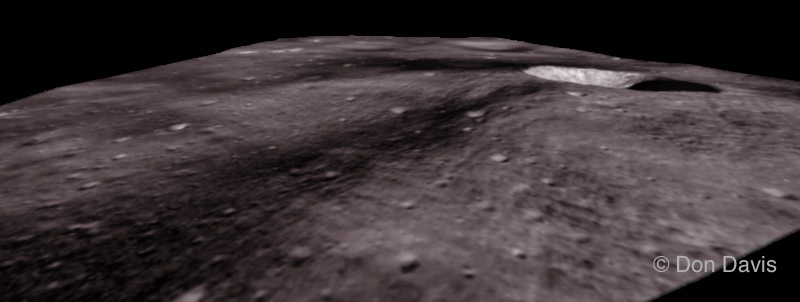
Another real lunar scene, this view looking across the interior of the prominent crater Copernicus. A detailed gray scale digital elevation model of the crater interior was painted, beginning with a contour map prepared by the U.S. Geological survey. A detailed Lunar Orbiter photograph was then scanned and the stripes retouched out, with the result used as a registered texture map.
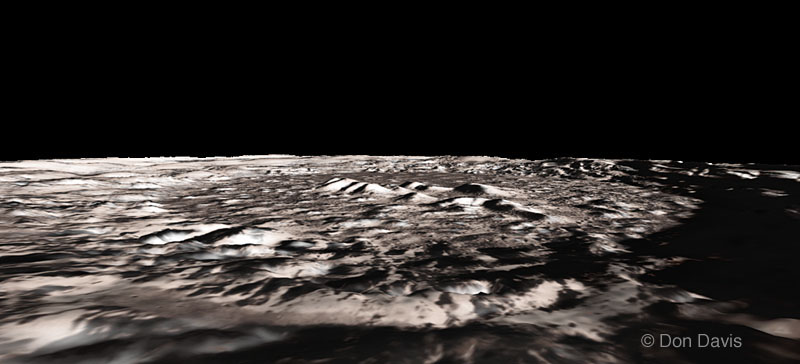
The planet Mercury is similar to the Moon with subtle changes in crater details caused by the increased gravity acting on the crater formation process. For this rendering a detailed digital animation model was hand painted matched visually to a detailed photo mosaic of the Caloris Basin. This view is similar to an oil painting I executed using perspective drawing techniques a quarter century ago. The resulting elevation model was then textured with an artistically treated version of the photo mosaic. The oblong Sun is a consequence of the distortion of a wide angle view flattened to a flat plane.

Below: The scorched surface of Mercury, innermost of the planets. This is cropped from one of the 'fisheye' frames used in the final all dome animation.
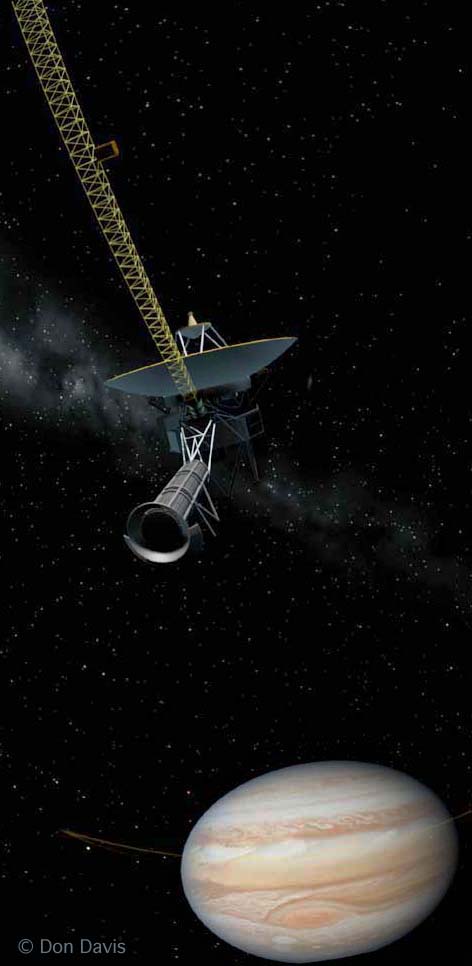
Right: A Voyager spacecraft flies past Jupiter, cropped from an all dome format frame.
Below: A frame from my animated simulation of the planetary impact which is believed to have formed the Earths Moon.
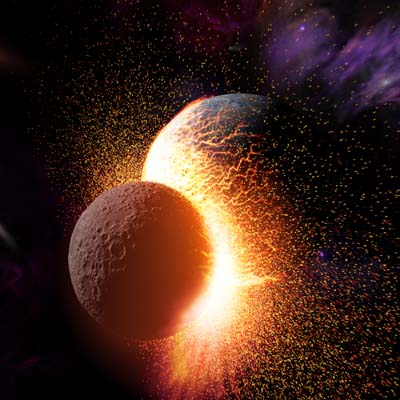
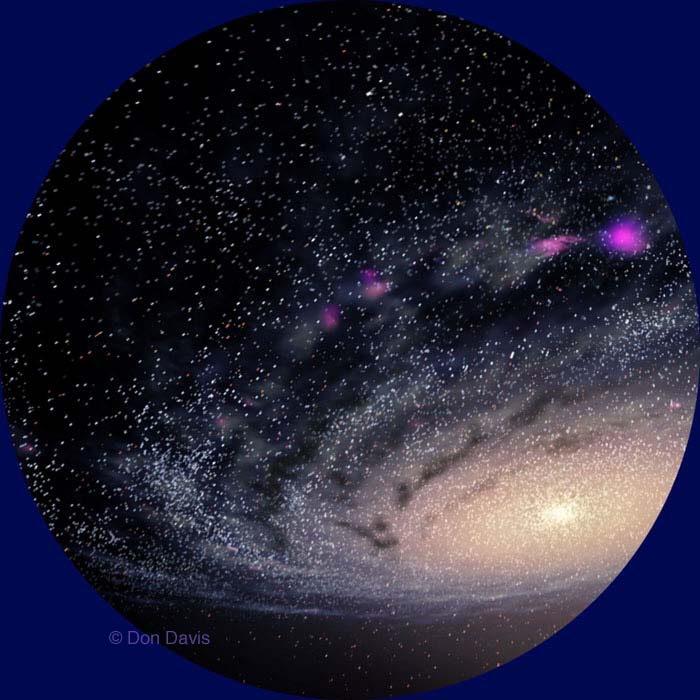
This galaxy scene was created as a 3D model. We entered the galactic plane and wandered among the stars, dark clouds, and glowing nebulae. The creation of such animations is time consuming but the results when seen on a dome justify it all.